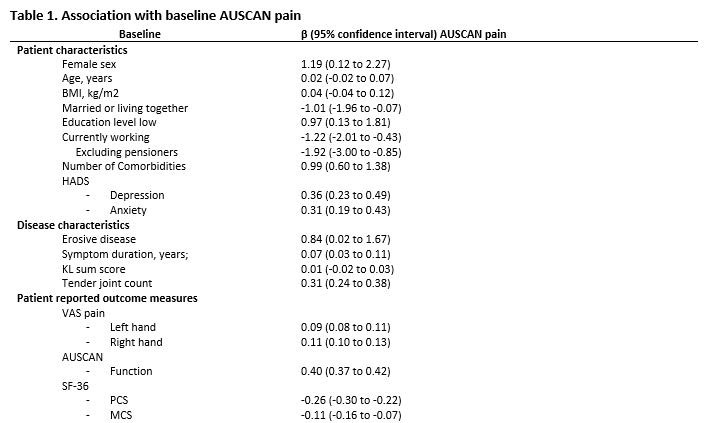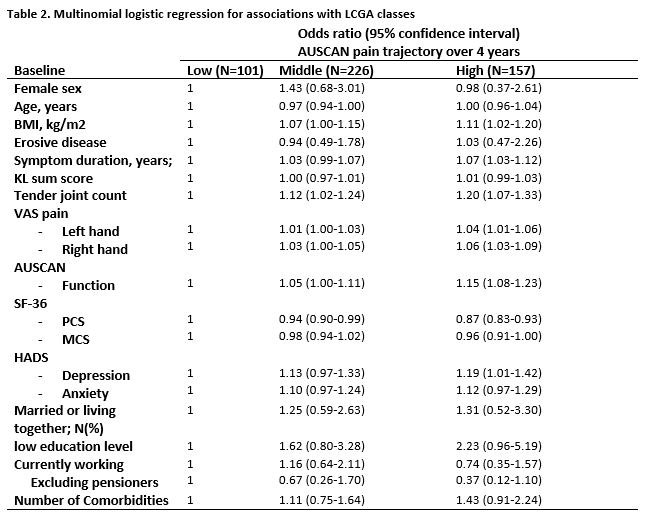Session Information
Session Type: Abstract Session
Session Time: 9:00AM-10:30AM
Background/Purpose: Pain is central to hand osteoarthritis (OA). Previous studies reported stable mean pain levels on the short to midterm. Subgroups with different pain trajectories have previously been found in knee OA. Similar subgroups of hand OA patients may exist. Knowledge of such subgroups may help inform decisions for treatment. Thus, we aimed to determine and characterize subgroups with different pain trajectories over four years in patients with hand OA.
Methods: Data from the ongoing HOSTAS (Hand OSTeoArthritis in Secondary care) cohort were used, collected from consecutive patients at the LUMC Rheumatology outpatient clinic with primary hand OA followed for four years. Hand pain measurements were collected annually from baseline using the AUSCAN pain questionnaire (range 0-20).
Associations of factors of interest and baseline AUSCAN pain were investigated with univariate linear regression.
Development of pain over time was modelled using latent class growth analysis (LCGA), which divides the cohort into subgroups based on pain development. The optimal model was selected based on the AIC, BIC, entropy, parsimony, clinical interpretability and likelihood ratio test for models with n vs n-1 classes. LCGA requires ≥2 measurements per case, so participants with 0-1 measurement were excluded.
Associations of LCGA classes with baseline demographics and factors of interest were analyzed using multinomial logistic regression, adjusted for baseline AUSCAN pain score.
Results: Of 538 participants, 484 completed the AUSCAN at ≥2 timepoints. Included and excluded patients were comparable at baseline. Of the included participants 86% were women, mean (SD) age was 60.8 (8.5), 29% had erosive disease, median (IQR) symptom duration was 5.2 (1.9-12.2), and 91% fulfilled the ACR criteria for hand OA. Mean AUSCAN pain score was 9.3 (4.3).
Higher AUSCAN pain scores at baseline were associated with male sex, not living together, lower education level, currently working, more comorbidities, higher HADS scores, erosive disease, longer symptom duration, higher tender joint count, higher AUSCAN function scores and lower SF-36 scores (table 1).
LCGA yielded three classes (figure 1), named high, middle and low based on the intercepts. Classes were primarily characterized by different pain levels at baseline; pain remained stable over time. Classes with higher pain levels were associated with higher BMI, higher tender joint count, longer symptom duration, more comorbidities, worse AUSCAN function scores, worse SF-36 PCS scores, worse HADS scores, and lower education level (table 2). No associations between LCGA classes and coping styles or illness perceptions were found (data not shown).
Conclusion: LCGA showed three subgroups with different pain trajectories in patients with hand OA, with different baseline pain levels and stable pain over time. These subgroups were associated with disease characteristics, number of comorbidities, psychological distress, BMI, education level, and health-related quality of life, which was comparable to the associations with baseline pain. This knowledge can help further development of treatment for hand OA and inform patients about the disease course.
To cite this abstract in AMA style:
van der Meulen C, van de Stadt L, Rosendaal F, Runhaar J, Kloppenburg M. Determination and Characterization of Patient Subgroups with Different Pain Progression in Hand Osteoarthritis [abstract]. Arthritis Rheumatol. 2022; 74 (suppl 9). https://acrabstracts.org/abstract/determination-and-characterization-of-patient-subgroups-with-different-pain-progression-in-hand-osteoarthritis/. Accessed .« Back to ACR Convergence 2022
ACR Meeting Abstracts - https://acrabstracts.org/abstract/determination-and-characterization-of-patient-subgroups-with-different-pain-progression-in-hand-osteoarthritis/



